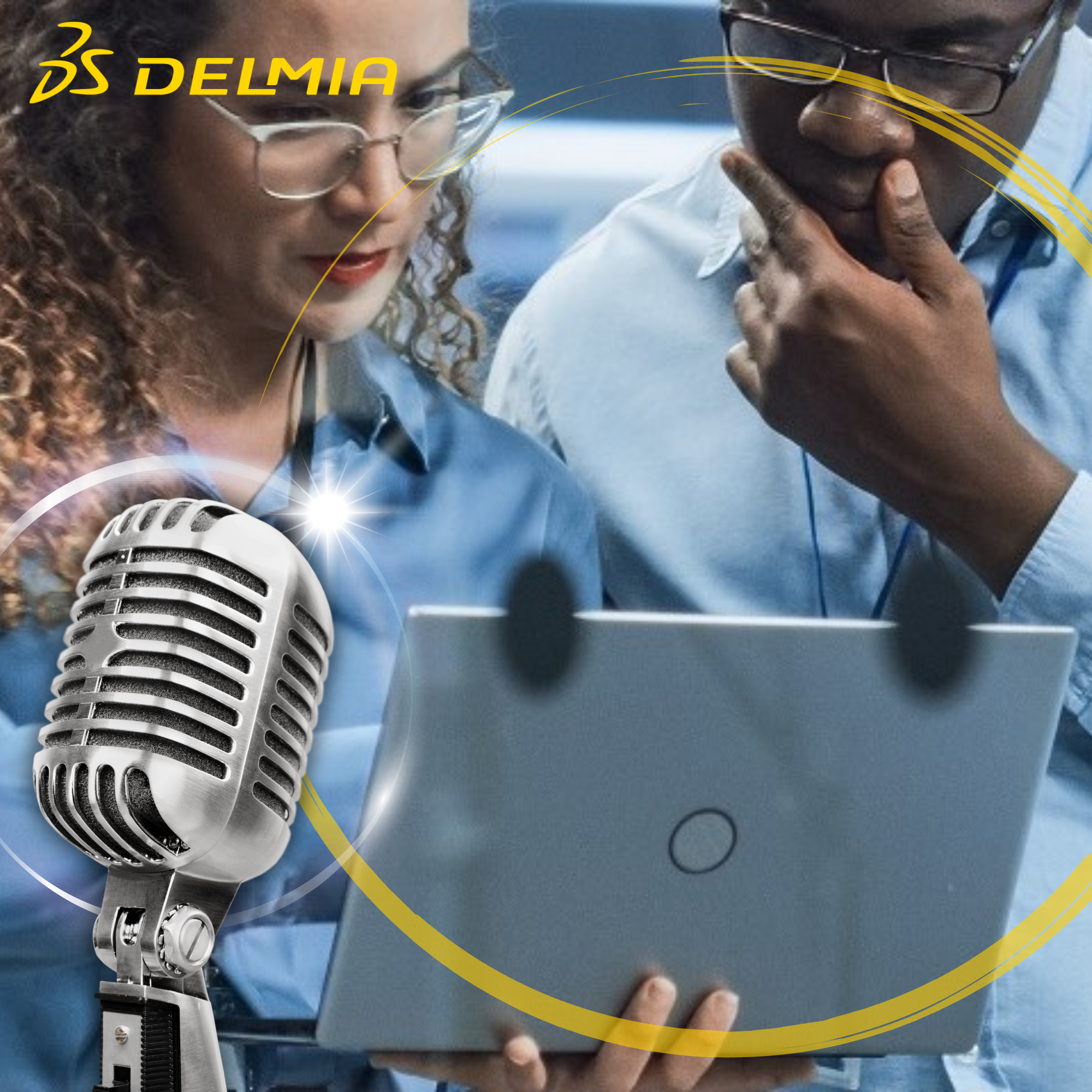Ep: 30 Virtual Commissioning Revolutionizes Robotics
In episode 30, Dan Birkett, DELMIA Industry Process Senior Consultant, Operations Engineering, discusses how DELMIA Virtual Commissioning helps test and validate automation control systems.
How to target 100% cycle-time accuracy
Tune in to hear about the benefits of virtual commissioning. DELMIA’s own Dan Birkett fills in the blanks to many questions you may have about virtual commissioning and robotics. For example, by connecting the DELMIA robot model to the Virtual Robot Controller (VRC), then 100% cycle time accuracy can be targeted. But did you know that it is used to validate the entire manufacturing system? This could be a robot line or even a whole factory that is supervised and orchestrated by PLCs. In fact, unit testing, such as a robot station, can be performed by simulating part creation and part transformation as it travels through the system.
With DELMIA Virtual Commissioning solution, you will be also able to:
- Create a Virtual Twin
- Program and Simulate Robots, Conveyors, AMR’s, etc.
- Communicate easily through CATIA Control Build with the Control Program, from any PLC solution
Discover more information on Virtual Commissioning by downloading our e-book, “Optimizing the Manufacturing Line with Virtual Commissioning” and visit our DELMIA Robotics webpage.
Meet Our Speaker

Dan Birkett
You can follow the DELMIA "Global Operations on the Go" podcast on Apple podcasts, Spotify, YouTube Podcasts, Deezer, by RSS or wherever you get your podcast


![]()


SPEAKERS
Dan Birkett, Therese Snow (host)
Therese: Welcome to our DELMIA podcast, Global Operations on the Go. Today we're going to dive into the topic of DELMIA Robotics Virtual Commissioning with Dan Birkett. Dan is a DELMIA industry process, senior consultant operations engineer. He's been with DELMIA for 12 years and is known to many as the robotics guy. Dan, welcome!
Dan: Thank you, Therese, for inviting me to this podcast.
Therese: Oh, absolutely. I am really glad that you can join us today. So to get started, why don't you tell our listeners a bit about your background and how you got interested in robotics?
Introducing Dan Birkett
Dan: Sure. So while studying in England, I gained an interest in industrial robots. The university I attended had a robot and I used Deneb I-grip to program the robot. After completing my studies, I hired directly into Deneb in the UK to support I-grip and virtual nc; virtual nc being a DELMIA NC Machining process verification and validation application. After the acquisition of Deneb by Dassault Systemes, the next step in my career brought me to Michigan to start up the processes. That provided services to DELMIA customers. 12 years ago, my career path came full circle as I rejoined, Dassault Systems DELMIA. I more recently joined the Industrial Processes Manufacturing team with a focus on robotics and virtual commissioning for the aerospace and defense industry.
Therese: All right, great. Well, it definitely sounds like you've been involved in robotics for quite some time, Dan. So can you please explain to our listeners what virtual commissioning is?
What is virtual commissioning?
Dan: Sure. So the first stage in the process is simulation when robot tasks are created and simulated in DELMIA, the robot spot simulation app is used to simulate point fastening applications like spot welding and drilling and riveting. The robot arc simulation application is used to simulate curve following paths like arc welding and seam sealant application, and the robot surface simulation app is used to simulate paths across surfaces like painting, polishing, standing, laser ablation, and surface sealant application. Any collisions or faults in the robot tasks are resolved before the next stage. The next stage is virtual commissioning. Programmable logic controllers. PLCs are typically used to supervise the coordination of multiple robots in a station and multiple stations on the line. The DELMIA Robot Virtual Commissioning app is used to emulate and validate the PLC controls logic that orchestrates the station and or line. CATIA Control Build is used as a conduit between the virtual P L C we call software in the loop or the real P L C we call hardware in the loop.
Therese: That's interesting. Dan, as I understand, Dassault Systemes has a new release, 3D EXPERIENCE release 2023X. Can you let our listeners know more about how DELMIA Robotics Virtual Commissioning and Control Build can help our customers?
3DEXPERIENCE 23X and Control Build
Dan: Yes, sure. So, CATIA Control Build is not only an application to emulate controls logic, it provides an environment to create and validate your controls in various forms. For example, sequential functional charts, functional block diagrams, structured text, C language, electrical diagrams, and of course ladder interactive graphical representations of H M I panels can be created and IO signals and other types of variables are mapped to push buttons, switches, lights, gauges, histograms, et cetera. These H M I panels are used to control the states of signals and emulate. What if situations such as running in manual or in automatic mode, how does the robot station line recover from an emergency stop, et cetera? In DELMIA, we can create different types of sensors. For example, beam sensors, light curtains, 3D sensors, and map in to these sensors. If a DELMIA sensor signal changes state, then the corresponding signal that it is mapped to in the P PLC and or control build also changes state, and the logic will be validated for what happens in the event of a sensor being tripped.
Dan: An example could be the virtual commissioning of a safety system to protect workers. What if a worker gets into a hazardous situation by activating a proximity sensor or a safety mat? Another example is to validate what happens when workers collaborate with robots. Robots speed override logic can be defined based on a worker proximity. As a worker approaches a robot, the robot will slow down or even stop DELMIA Robot. Virtual commissioning in conjunction with control build also provides a great platform for training robot programmers and controls. Engineers can learn in a virtual or classroom environment by familiarizing themselves with a simple system before tackling more complex environments.
Virtual robot cycle vs. physical robot
Therese: So the virtual robot cycle time and trajectory be simulated, of course, with nearly what percent accuracy compared to the physical robot.
Dan: Well, the DELMIA robot models mimic the behavior of the real industrial robot in every possible way. Joint limits, joint and TCP max speeds, acceleration and decelerations rates are applied forward and inverse kinematics are applied to the robot model for accurate joint and linear motion. Realistic robot simulation and is used to simulate a robot task in DELMIA. So instead of using the DELMIA agnostic motion planner, the motion will be controlled by the robot vendors' robot controller simulation or RCs module. The RCs are extracted from the actual robot controller software, but does not consider the execution time of instructions like IO and Conditional Logic. As a result, a hundred percent accuracy of cycle time cannot be achieved. Two goes beyond the capabilities of standard r r s, although is supported by a limited smaller number of industrial robot vendors. By connecting the DELMIA robot model to the virtual robot controller, the VRC module, then 100% cycle time accuracy can be targeted. The virtual robot controller is the actual robot controller software so that we can drive the DELMIA robot model with the Native Robot program and with the real robots motion planner.
Therese: So can you discuss a little bit more about virtual validation?
Validating the entire manufacturing system
Dan: Sure. Yes. So virtual commissioning is used to validate the entire manufacturing system. This could be a robot line or even a whole factory that is supervised and orchestrated by PLCs. Unit testing such as a robot station can be performed by simulating part creation and part transformation as it travels through the system. Virtual commissioning is not limited to robotic manufacturing systems, but could be used to emulate what happens underneath an airport. For example, baggage handling systems are a series of powered conveyors and RFID readers. The logistics of a baggage handling system can be emulated with DELMIA and control build.
Therese: Thank you, Dan, for taking the time to speak with me today.
Transcript by Rev.com
Closing remarks
Dan: Thank you. Therese for giving me the opportunity to talk about DELMIA Robot Virtual Commissioning.
Therese: I'm certainly glad you took the time. I'm sure any, our listeners will really appreciate all the information you gave. Thanks to our listeners for tuning in. For more information on virtual commissioning, look for a link where this podcast is posted. I'm your host, Therese Snow, and you've been listening to DELMIA's Podcast Global Operations on the Go!

